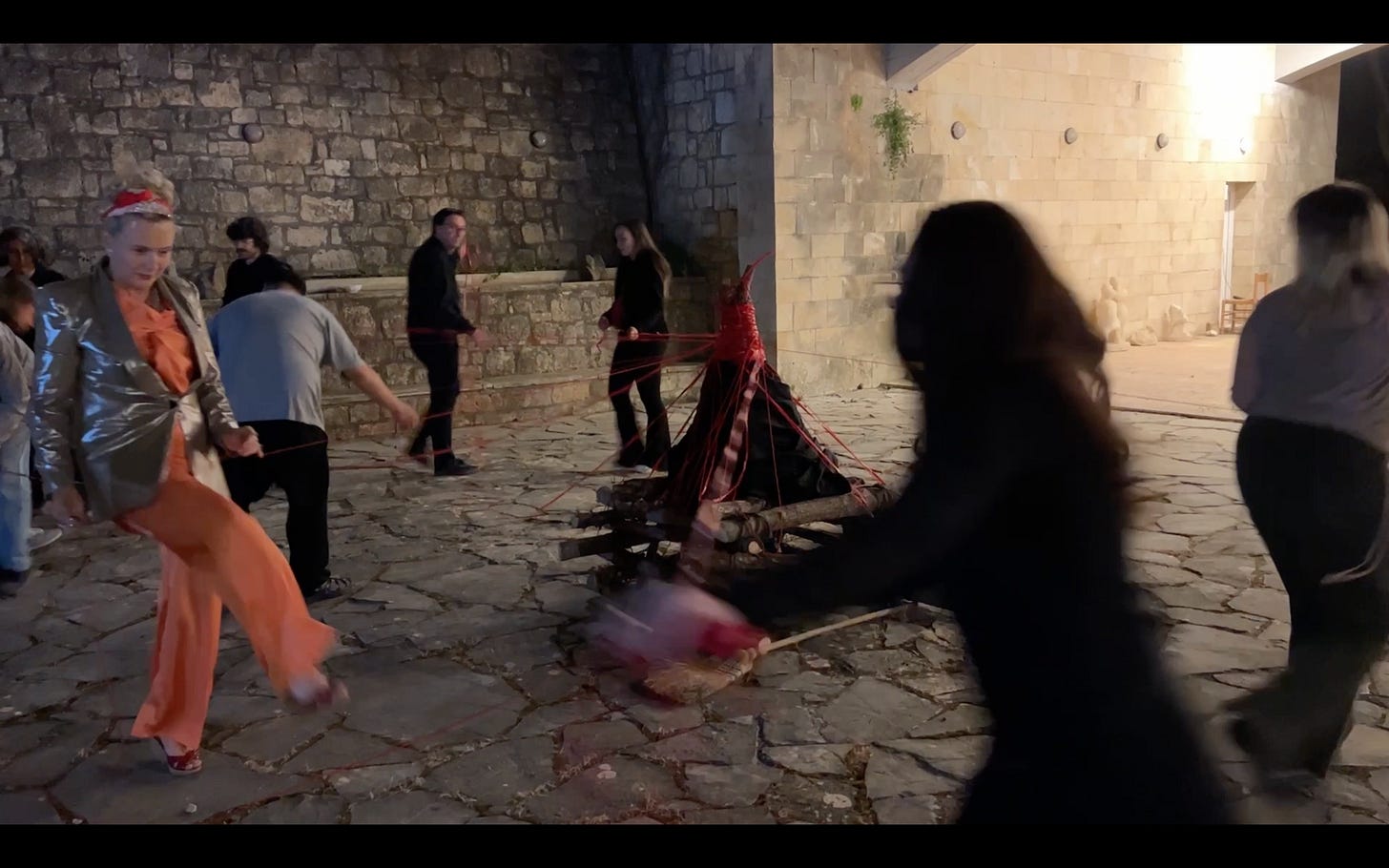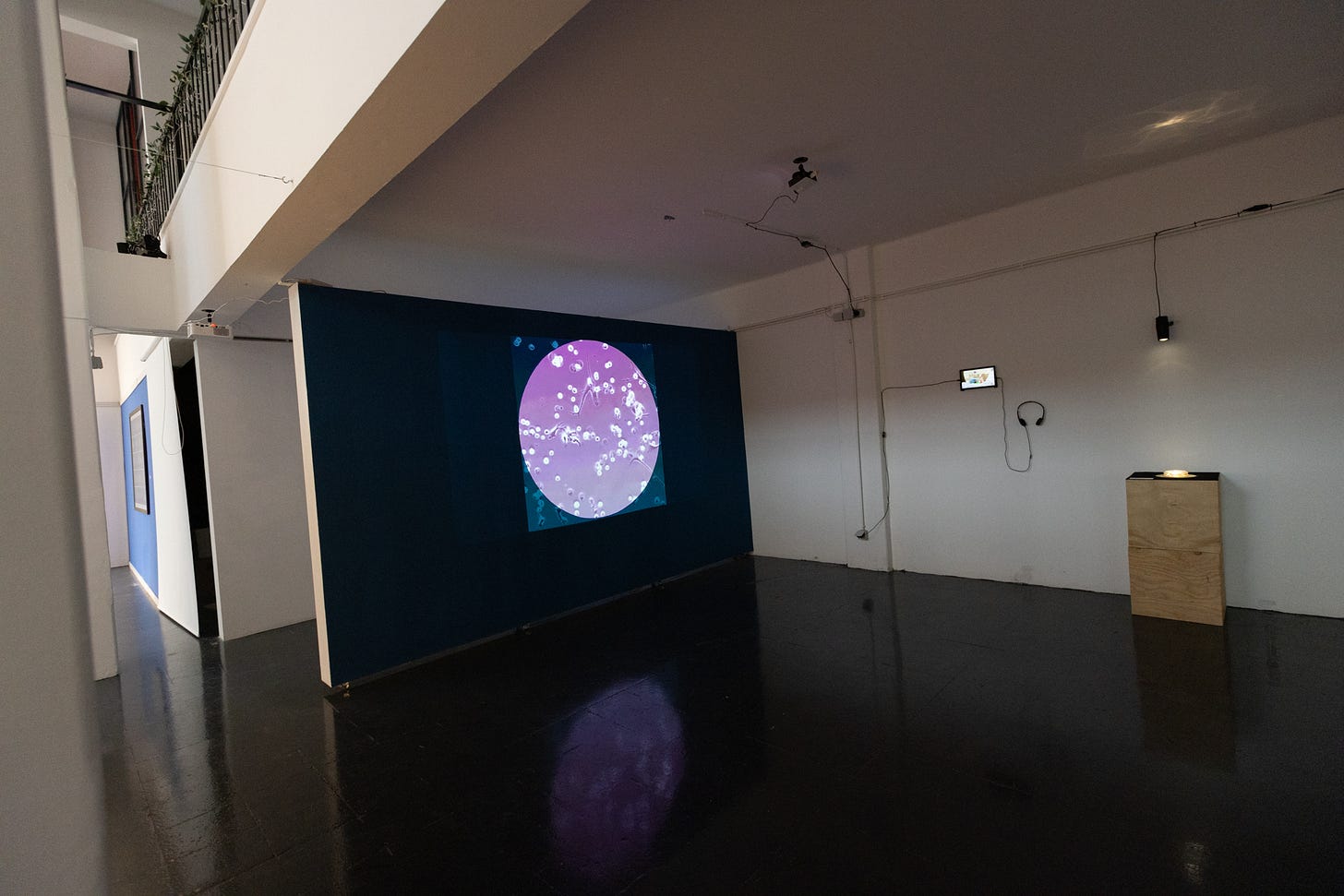A year on fire, and the Blood Riot ahead
An end-of-year unfoldings, and new projects on the front burner
As the end of the year (and my birthday) approaches, I find myself less interested in tidy summaries and more compelled to examine the unresolved—the still-unfolding.
This time a year ago, I had just submitted my thesis. Then, after seven additional months of institutional red tape and teeth gnashing, I graduated. Submitting the thesis / graduating was less a conclusion and more so an uneasy (but generative) freefall through a liminal space where new trajectories emerged—and these have been exciting.
Speaking of emergence, this coming December 31st will see the birth / unearthing of the alchemical gestation of Homuncularium Basiliscus—an ancient protocol twice bastardized, which I performed in Cornwall with my queer sperm donors on the lunar eclipse of March 2024 (pictured below). This 2xbastardized protocol, secretly enacted and video recorded as a small group ritual, was inspired by a beautifully illustrated (and reimagined) transcription of Paracelsus’ 17th century instructions for how to grow a miniature human in vitro with semen. The illustration (pictured below, third image down) is part of the Richel collection at the Museum of Witchcraft and Magic, and was included in my year-long exhibition at the museum. It reconfigures Paracelsus’ recipe by replacing the requisite semen with menstrual blood, to grow a basilisk instead of a man—menstrual blood being monstrous, after all. To bastardize this bastardization, I then re-imagined the protocol as a combo of both: queer semen and menstrual blood, to grow a human-monster hybrid. On New Year’s Eve, the results of this experiment will be unearthed from the manure-lined hole it was ritually buried in for incubation.


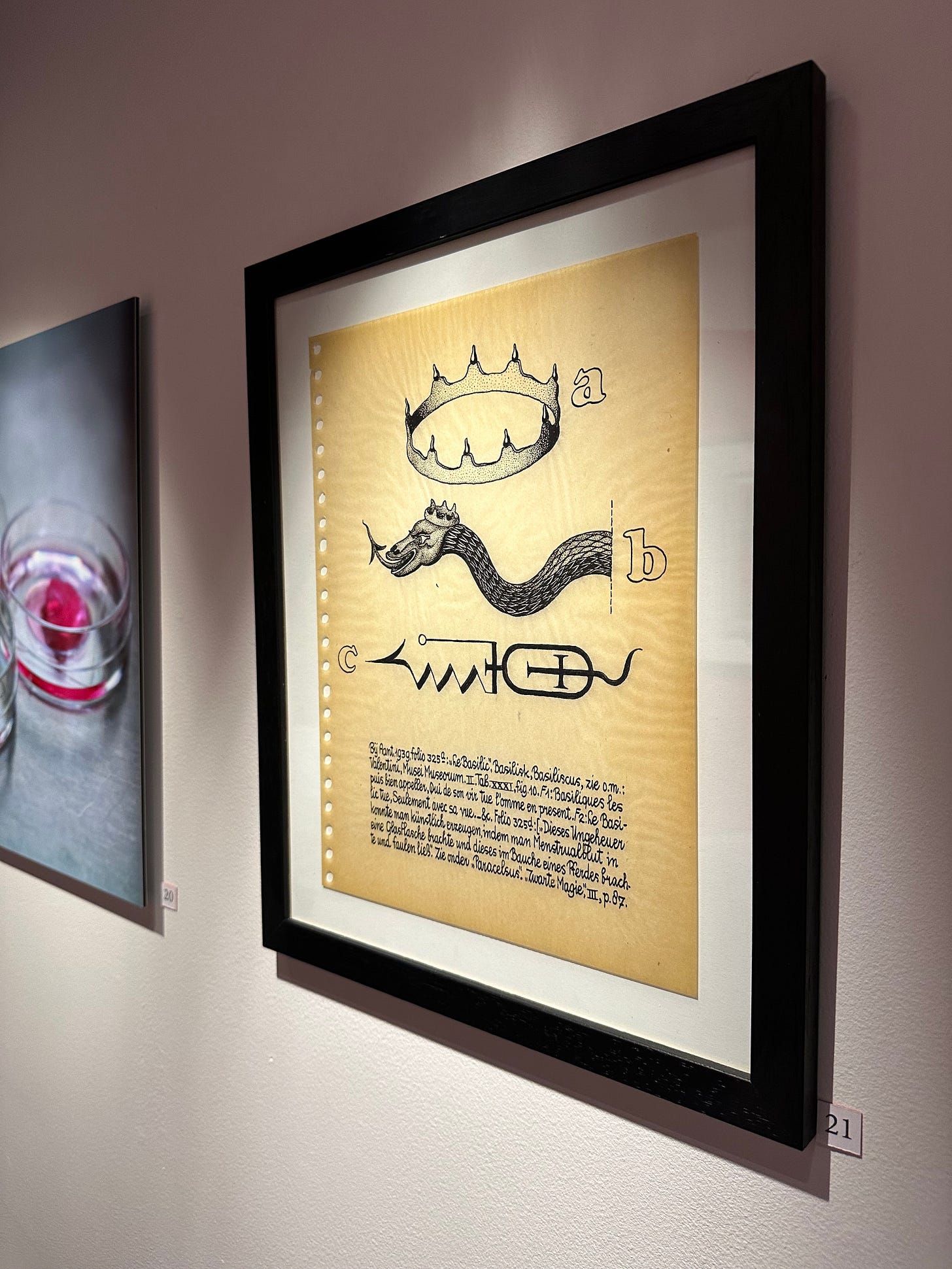
December 31 will mark the 40-week gestation period of these untouchable materials, hermetically sealed in glass, buried in horse shit, and fed with what I call arcanum sanguinis foemina, or female occult blood—and, menstruation is occult because it is hidden (occulted) knowledge, for better or for worse. This ritual and its impending culmination also reflect the thematic core of my thesis: the interplay between the monstrous and the generative, as well as the personal and the cultural, and the alchemical marriage of the two. It’s not an isolated project but also a statement about how we carry forward and revision the knowledge and practices we inherit, and are titillated by.
This ties closely to my experiences curating the Arcanum Sanguinis: Occult Blood exhibition, as a project that extended the themes of my thesis into the realm of public engagement. Interpreting research within a museological context allowed me to think critically about how these materials and narratives can be made more accessible and impactful for diverse audiences, without losing the edge that characterizes them.
This ethos of revisiting and reimagining practices also informed my work on the Mooncalf Homuncularium project in Crete with filmmaker, Elizabeth Littlejohn—a direct extension of the ritual in Cornwall but in a distinct mythological milieu linked to Ariadne and her red string. The Mooncalf Homuncularium expanded on the ideas of generative monstrosity, within the thematic residency of the TTTlabs BioFeral BeachCamp, to dance within and around the boundaries of reproductive autonomy. Together, Elizabeth and I worked to create a performative and immersive environment where participants could engage with layered histories of alchemy, biotech, and feminist storying. The work echoed the speculative inquiries of my thesis and artistic practice, while rooting them in a shared process of collaborative creation. Body fluid donations came from several ritual participants, including semen, tears, saliva, and menstrual blood. Such projects reaffirm my commitment to using ritual as a method for interrogating cultural and scientific practices. These offer a space where monstrosity is celebrated not as aberration but possibility, as generative intrigue. What could it mean to embrace monstrosity, not as a failure of the normative, but as an active site of resistance and tech innovation?

The invocation of Ariadne's red string—a symbol of navigation and destiny, and now bioethics—became a central metaphor for weaving together the contributions of participants, linking their bodily fluids to larger narratives. The ritual we enacted served as an embodied interrogation of the tension between agency and collaboration, rethinking the potential for collective generative practices. Each fluid contributed to the homunculus gestation became a material archive of personal and communal intention, blending the personal and the culturally profane, the scientific and the magical.12 This red string motif will continue into 2025, a wayfinding device that is about to guide my work through a major culminative project, which I can’t talk about yet!
Building on these explorations of ritual, monstrosity, and collective creation, my work that followed at the Gulbenkian Institute for Molecular Medicine at uLisboa, through Cultivamos Cultura, brought these speculative narratives back into the laboratory. Here, I extended my ambitious (long-term) bioengineering project, Sentient Clit (with Jiabao Li) to translate the metaphorical and metaphysical into tangible biological experiments by differentiating menstrual stem cells into neuronal types. This process—where cultural, symbolic blood meets its cellular and scientific counterpart—continued to extend the generative themes of my thesis into the distinctly empirical. It was very nice to be back in a lab coat.
Cultivating menstrual stem cells and inducing their transformation into neurons was as much about pushing scientific boundaries as it was about exploring the potency of menstruation and its hidden (occulted, remember?) potential. By engaging with the cellular materiality of menstrual blood, the project continues to challenge persistent cultural stigmas surrounding menstruation. At the same time, it invites reflection on how biotechnological processes can carry forward feminist critiques and speculative inquiries. Working within Cultivamos Cultura's residency framework allowed me to continue to explore these intersections in a dynamic, high profile research environment.
The lab is a space for rigorous experimentation and cross-institutional exchange, and in this instance stem cell differentiation mirrored the broader narratives of change and adaptation that run through my artistic practice. By transforming what has been culturally coded as waste into possibility—not only for regeneration but also synthetic sentience and erotic pleasure (gasp!), my project interrogates deeply ingrained notions of value, productivity, and purity while also playfully poking at research gaps in the fields I commingle within.3 This work underscores my commitment to bridging the speculative and the material, the symbolic and the empirical. The neurons derived from menstrual stem cells are not just cellular structures; they become vitalized questions about the boundaries of the human and the monstrous, the normative and the generative.

During this residency period, I recovered from the demoralizing experience of the thesis defense and completed my final revisions. Lisbon was a gentle, gorgeous place to do that. Returning to Canada after these explorations, I immersed myself in FEMeeting, a unique platform dedicated to women in art, science, and technology. The timing was perfect—it allowed me to transition from the intensity of residencies and thesis trauma into a space of communal dialogue, playfulness, and support. FEMeeting provided a much-needed opportunity to reconnect in-person with a global network of stellar women whose practices resonate deeply with my own. The relationships I built and strengthened through FEMeeting are instrumental in shaping my 2025 plans, but I can’t talk about that yet, either! This network, and other networks I belong to, such as ecoartspace (US/ Australia-based) and Art Research Ecology (UK-based) are more than just professional connections; they remind me that my work, though deeply personal, is part of a larger collective effort.
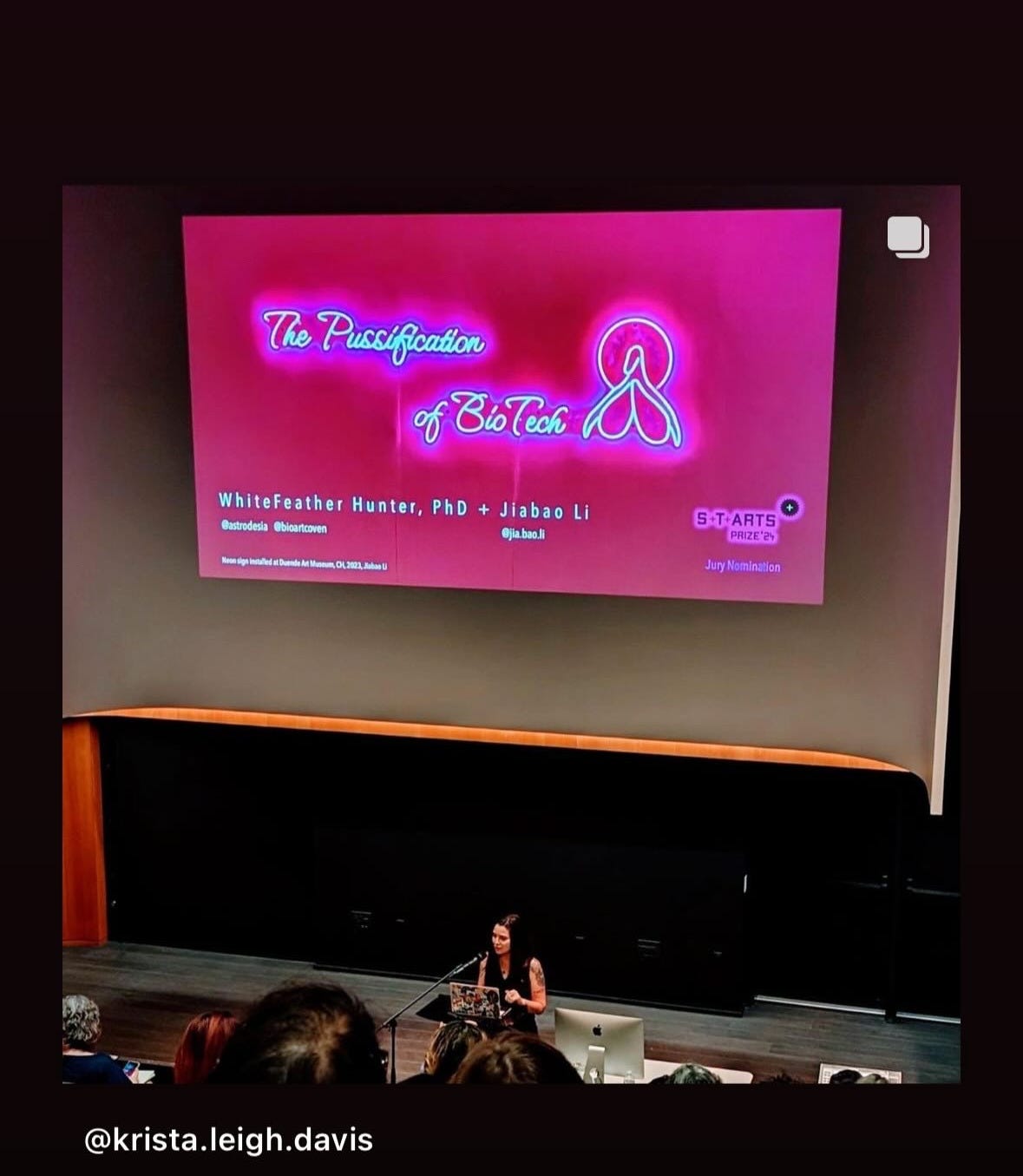
It’s REALLY, really easy to feel like the interstitial space between finishing an all-consuming PhD and moving on to the next academic appointment (or whatever) is a space of doing nothing significant. But in the past year, aside from defending my thesis, writing revisions, and graduating, I completed the three funded residencies in the UK, Greece, Portugal and am now engaged in two others concurrently, here in Canada; I had my work shown in six exhibitions in Portugal, Germany, the US, the UK, Australia, and Canada; had my artwork and academic writing published in numerous books, journals, podcasts, documentaries, articles, and catalogues in Denmark, the US, Portugal, Germany, the UK, Greece, and Austria; gave seven artist talks/ conference presentations in the UK, Canada, Australia, and Greece, including a keynote address; and created new (funded) artworks. These new works include two projects in process, which will bleed into 2025: NEW SUNS through Artengine and in partnership with the University of Ottawa Heart Institute (Alarcon Lab) for which I am hacking a 3D bioprinter (called IMARA) to print new menstrual stem cell forms; and, a project called Trans-planted Signals: Navigating Sensory Relationships with Plants, Place, and Colonial Pathways which takes place in Maui and is for an exhibition in Australia through ecoartspace. I’m also working on completing a new work for an upcoming exhibition in Portugal in May. IMARA will be shown in Ottawa in June. Next month, I’m starting off 2025 with a bang by giving a keynote lecture in Ireland at University College Cork’s Future Humanities Institute, as well as a talk in Cyprus at NeMe Arts.4 I have to revisit these accomplishments to remind myself that indeed, I have been doing something. I’ve also been slogging through sorting and offloading everything I’ve had in a storage unit for the past three years, as well as filing four years worth of neglected income tax returns. The piles of shredded paper I’ve produced have also been significant.
This past year has been an exercise in returning to myself as an artist, stepping outside the structured confines of academia and the privileges of institutional affiliation. I’ve relied more heavily on my own initiative again, along with my newly honed abilities to synthesize disparate ideas into coherent forms. It continues to be a process of edgy experimentation and risk-taking—sometimes messy, often challenging, always exhilarating. Revisiting core themes of my thesis through new projects helps me to see them not as fixed points, but as evolving questions that continue to shape and reshape my practice. The legacy of academic rigour continues to influence my approach to topics, grounding my explorations in thorough research and critical frameworks to ensure that my work remains intellectually robust.
The themes I explored in my thesis through the lenses of witchcraft, sex, blood, and biotech have proved remarkably elastic, and remain aloft the ever-ascendant arc of feminist social agitation. The questions I posed—about the (gendered) boundaries between the human and more-than-human, the personal and the collective, and the speculative and the material—have continued to drive my work. 2025 feels less like a tabula rasa and more like a palimpsest, or a continuation of many threads. OH, and…
Blood Riot!
I’ve also been working the past month or so on developing a new tarot deck, which I’m calling Blood Riot!, focused on self-actualization through bodily autonomy. Paid subscribers can continue reading below about the deck, as well as have a glimpse of more of the juicy visuals.
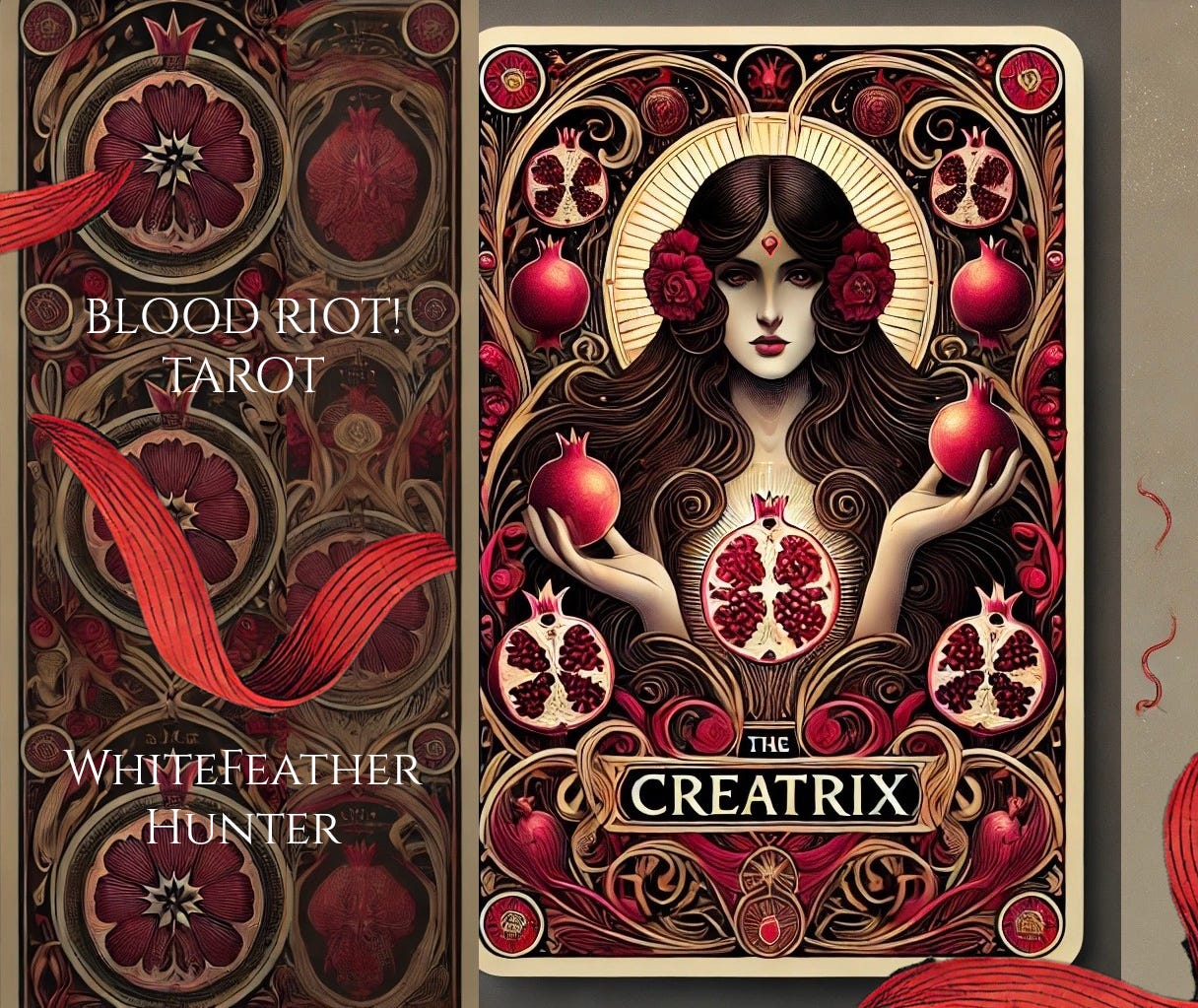
Keep reading with a 7-day free trial
Subscribe to Frantic Panties to keep reading this post and get 7 days of free access to the full post archives.





